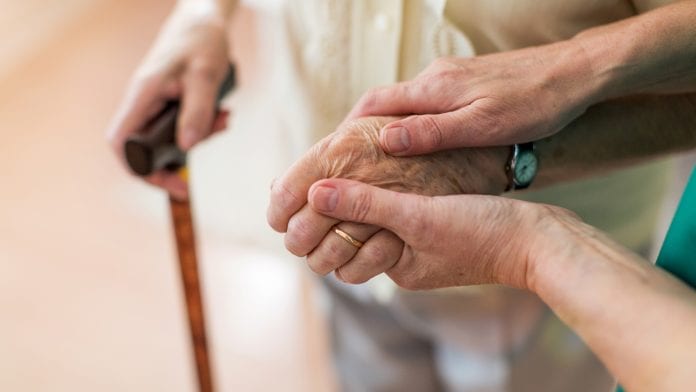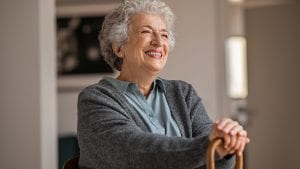
Alyson Scurfield, TEC Services Association (TSA), explains how enhancing technology in social care could aid more effective preventative care models and empower individuals and local communities.
The preventative power of care technology never ceases to amaze me. Take the story of Joan who has dementia and used to go missing between 3pm and 4pm every afternoon. Her relatives and friends just could not get in touch. Joan would not answer the door or pick up the phone – it was a complete mystery, and her family were becoming increasingly worried.
When Joan* was first diagnosed with dementia, she and her children decided to have a sensor system installed in her home. This gave them all reassurance: her family got to know their mum’s regular, daily movements and they received an alert if something was not normal. Joan felt comforted that her family were looking out for her, and she felt good about living independently in her own home.
When her children asked where she went every afternoon, Joan described a memory of coming home from school during the war and her mother telling her to go down to the air raid shelter. She told them that she had been hiding under the stairs for an hour every single afternoon, feeling afraid and anxious.
Here, the home monitoring system in Joan’s home gave her family specific information that helped them to support her sensitively and proactively. Rather than panicking and thinking their mum could not live safely alone anymore, they put a positive, pre-emptive plan in place that was personalised to Joan’s situation.
Every day at 3pm, the family and home care agency took turns to phone Joan and reassure her. As a result, her wandering stopped, and Joan continues to live happily in her own house. Her family feel the information flagged by the sensors was invaluable – it empowered them to give Joan the support she needs. They also feel that left unchecked, Joan’s anxiety and wandering may have prompted a deterioration that could have quickly led to residential care.
Other families using similar technology often report that the quality of conversation between them and their parents improves hugely. This is because the alert system reassures relatives, so they question their mum and dad less about what they have been doing or what they have eaten. Instead, they discuss topics that everyone is interested in, and those richer conversations have a positive impact on their relationships.
Unfortunately, the use of technology in this way is still not the norm. For too long, cash-strapped social care services have had to react to events, acting only when there is an incident or call for help. The problem with this reactive approach is that both the individual and their carer are often closer to the point of crisis. At this late stage, interventions are more limited, more costly and they offer less choice and control for the individual.
Joan’s story shows the role that technology can play in identifying people at risk of reaching a crisis before they get there. Support can be put in place earlier, helping to build confidence and skills so individuals, their families and carers can maintain health and independence themselves. As with Joan’s story, this model taps into family and community networks, it reduces dependency and cuts the burden on carers.
Importantly, this approach also ensures that support can meet people’s individual needs. It makes care personal so they can continue doing the things that matter most to them, enriching their everyday lives, in the communities they love.
Another example of the proactive power of technology enabled care can be seen in Cardiff. In 2020, the council’s implementation and delivery manager, Aaron Edwards arranged for smart watches to be given to twenty people in the local area who were at risk of falling. Risk modelling and early detection software analysed their mobility and sleep data and indicated if they were likely to fall.
Preventative measures such as referrals to a physio, GP, occupational therapist, or community exercise scheme were then put in place. To complement this anticipatory approach, which combines a person’s health statistics with AI to predict the likelihood of someone falling before it happens, a proactive calling programme was set up by Telecare Cardiff. Every person who fell was contacted within 48 hours to discuss the nature of the fall.
This shift to a more proactive and predictive model of service delivery is not just a new way of working, but a fundamental practice that is helping the team understand why someone has fallen and if there are any corrective measures that can be implemented to prevent future falls.
Data from proactive calls shows that, of those people who fell the day before, 51% regularly visited the toilet at night. Interestingly, 5.4/ 10 was their average score in terms of mental and physical wellbeing (where one equals ‘depressed’ and 10 equals ‘very happy’). Over one fifth had not had their eyes tested for two years and just under half were wearing slippers when they fell.
This data is helping Telecare Cardiff to personalise interventions and develop partnerships with other services and community networks so it can provide a holistic response going forward.
The service is now planning to combine data from an individual’s early detection smartphone app with their falls score and falls history record. These analytics will sync to a falls dashboard that tracks improvements, triggers interventions, and reduces the likelihood of repeat falls.
The next step is to include all customer data on an early detection portal. This will allow telecare response officers to gather meaningful data when they visit a person who has fallen. They select the reason for their visit, which creates a ‘workflow’, allowing telecare operators to proactively contact those people who have fallen. This ensures that all telecare citizens, not just those fitted with the wearable smart watch, will be supported.
Developing more proactive, predictive approaches to care like this is a key recommendation from the recent ADASS TSA Commission which explored how technology can be truly integrated into social care.
Set up by ADASS (Association of Directors of Adult Social Services) and my organisation, TSA (TEC Services Association), the commission considered evidence from almost 60 people, including individuals and their relatives who access social care support, front line care professionals, directors of adult social care, housing and health leaders and technology suppliers.

We heard about a number of inspiring local initiatives, showing how technology can be used proactively, shaping care services around people and their families, and putting power into their hands. But these are in the minority – they are not commonplace – and, in its final report, the commission concluded that the majority of care providers and councils are not using available technology within social care to keep people safe, happy, and healthy.
That is why ADASS and TSA are calling on the government to fund a two-year programme of ten social care innovation projects to begin that process of normalising the use of digital within social care.
A blueprint of best practice from this proposed ‘Personalised Care Innovation Programme’ will then be rolled out to care providers and local authority adult social care services in England to create a national, digitally enabled social care system. The commission recommends that multi-year funding from central Government is needed for this country-wide deployment.
As ministers consider how to reform England’s social care system, I urge them to put technology at the heart of any proposals. Not only can digital devices and systems – from specialist kit to everyday apps – prevent people’s health and wellbeing deteriorating, they can also empower individuals and local communities, creating more sustainable social care for the future.
Download the ADASS TSA Commission report on integrating technology into social care here.
*Joan’s name has been changed
Alyson Scurfield
Chief Executive
TEC Services Association (TSA)
www.tsa-voice.org.uk
This article is from issue 18 of Health Europa. Click here to get your free subscription today.









